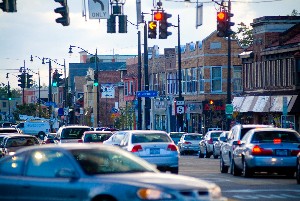Engineers from University at Buffalo in New York have developed a technique to route drivers to their destinations while minimizing their cars’ greenhouse gas emissions. The study involved simulations of traffic in the Buffalo/Niagara Falls region, but could be applied to today’s GPS systems in the near future, according to the researchers.
Buffalo engineering professor Adel Sadek and doctoral candidate Liya Guo linked algorithms from two simulation systems:
– Motor Vehicle Emission Simulator (MOVES), created by the Environmental Protection Agency that estimates emissions from cars, trucks, and motorcycles.
– Transportation Analysis Simulation System (TRANSIMS), from the National Infrastructure Simulation and Analysis Center at Sandia National Lab simulates the daily activities and movements of hypothetical individuals — not real people — in an urban region.
TRANSIMS simulates traffic in detail, accounting for factors such as location and pattern of signals, the grade of the road, and the trips people take at different times of day. Adding in data to the models from the Buffalo/Niagara region, Sadek and Guo ran a number of simulations, rerouting travelers in new ways each time.
From the simulations, the researchers identified an optimal traffic pattern, where all drivers are traveling along the most environmentally friendly routes. With the traffic system in this state of equilibrium, moving a driver from one path to another would increase a user’s overall emissions by creating more congestion or some other problem.
Sadek and Guo found that environmental routing by area drivers could reduce overall carbon monoxide emissions by 27 percent, while increasing the length of their trips by an average of just 11 percent. In some cases, the routing adjustments were minimal, such as using surface streets instead of freeways, which reduces fuel consumption.
The researchers also identified the type of drivers, amounting to one in five of the total, who would benefit the most from environmental routing. Adjusting their driving routes, say Sadek and Guo, could reduce the area’s emissions by some 20 percent.
Sadek notes that onboard GPS navigation systems and online mapping programs could in the near future use green-routing algorithms to give drivers the choice of an environmentally friendly route instead of the shortest route. “We’re not talking about replacing all vehicles with hybrid cars or transforming to a hydrogen-fuel economy that would take time to implement,” says Sadek. “But this idea, green routing, we could implement it now.”
The research by Sadek and Guo is part of a larger initiative on intelligent transportation systems funded by the U.S. Department of Transportation.
Read more: Simulation Improves Safety at Traffic Intersections
* * *


 RSS - Posts
RSS - Posts
Science continues to support the case for curbing greenhouse gas emissions so as to minimise the risks of catastrophe.
The regulations won?? t require polluters to reduce greenhouse gas emissions but could in the future.
[…] Technique Devised for Lowest Greenhouse Emissions Routing […]